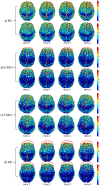4D segmentation of brain MR images with constrained cortical thickness variation
- PMID: 23843934
- PMCID: PMC3699620
- DOI: 10.1371/journal.pone.0064207
4D segmentation of brain MR images with constrained cortical thickness variation
Abstract
Segmentation of brain MR images plays an important role in longitudinal investigation of developmental, aging, disease progression changes in the cerebral cortex. However, most existing brain segmentation methods consider multiple time-point images individually and thus cannot achieve longitudinal consistency. For example, cortical thickness measured from the segmented image will contain unnecessary temporal variations, which will affect the time related change pattern and eventually reduce the statistical power of analysis. In this paper, we propose a 4D segmentation framework for the adult brain MR images with the constraint of cortical thickness variations. Specifically, we utilize local intensity information to address the intensity inhomogeneity, spatial cortical thickness constraint to maintain the cortical thickness being within a reasonable range, and temporal cortical thickness variation constraint in neighboring time-points to suppress the artificial variations. The proposed method has been tested on BLSA dataset and ADNI dataset with promising results. Both qualitative and quantitative experimental results demonstrate the advantage of the proposed method, in comparison to other state-of-the-art 4D segmentation methods.
Conflict of interest statement
Figures


 (or
(or  ).
).  is the cortical thickness measured from the inner surfaces (red curves). The dashed green arrows denote the registration operation to warp the corresponding thickness from the temporal neighborhoods to the current time-point. The dashed blue curves in the middle is the reasonable surface determined after measuring the cortical thickness difference between current time-point and two neighboring time-points.
is the cortical thickness measured from the inner surfaces (red curves). The dashed green arrows denote the registration operation to warp the corresponding thickness from the temporal neighborhoods to the current time-point. The dashed blue curves in the middle is the reasonable surface determined after measuring the cortical thickness difference between current time-point and two neighboring time-points.









Similar articles
-
Automatic segmentation of neonatal images using convex optimization and coupled level sets.Neuroimage. 2011 Oct 1;58(3):805-17. doi: 10.1016/j.neuroimage.2011.06.064. Epub 2011 Jul 5. Neuroimage. 2011. PMID: 21763443 Free PMC article.
-
A novel cortical thickness estimation method based on volumetric Laplace-Beltrami operator and heat kernel.Med Image Anal. 2015 May;22(1):1-20. doi: 10.1016/j.media.2015.01.005. Epub 2015 Feb 3. Med Image Anal. 2015. PMID: 25700360 Free PMC article.
-
Temporal filtering of longitudinal brain magnetic resonance images for consistent segmentation.Neuroimage Clin. 2016 Feb 16;11:264-275. doi: 10.1016/j.nicl.2016.02.005. eCollection 2016. Neuroimage Clin. 2016. PMID: 26958465 Free PMC article.
-
Cortical surface segmentation and mapping.Neuroimage. 2004;23 Suppl 1(0 1):S108-18. doi: 10.1016/j.neuroimage.2004.07.042. Neuroimage. 2004. PMID: 15501080 Free PMC article. Review.
-
A New Optimized Thresholding Method Using Ant Colony Algorithm for MR Brain Image Segmentation.J Digit Imaging. 2019 Feb;32(1):162-174. doi: 10.1007/s10278-018-0111-x. J Digit Imaging. 2019. PMID: 30091112 Free PMC article. Review.
Cited by
-
Abnormal Cortical Thickness Development in Young Adults With Heavy Cannabis Use: A Longitudinal Study.Addict Biol. 2025 May;30(5):e70040. doi: 10.1111/adb.70040. Addict Biol. 2025. PMID: 40344353 Free PMC article.
-
Content-based image retrieval for brain MRI: an image-searching engine and population-based analysis to utilize past clinical data for future diagnosis.Neuroimage Clin. 2015 Jan 15;7:367-76. doi: 10.1016/j.nicl.2015.01.008. eCollection 2015. Neuroimage Clin. 2015. PMID: 25685706 Free PMC article.
-
Examining Brain Morphometry Associated with Self-Esteem in Young Adults Using Multilevel-ROI-Features-Based Classification Method.Front Comput Neurosci. 2017 May 22;11:37. doi: 10.3389/fncom.2017.00037. eCollection 2017. Front Comput Neurosci. 2017. PMID: 28588470 Free PMC article.
-
2014 Update of the Alzheimer's Disease Neuroimaging Initiative: A review of papers published since its inception.Alzheimers Dement. 2015 Jun;11(6):e1-120. doi: 10.1016/j.jalz.2014.11.001. Alzheimers Dement. 2015. PMID: 26073027 Free PMC article. Review.
-
Compounding local invariant features and global deformable geometry for medical image registration.PLoS One. 2014 Aug 28;9(8):e105815. doi: 10.1371/journal.pone.0105815. eCollection 2014. PLoS One. 2014. PMID: 25165985 Free PMC article.
References
-
- SPM8 website. Available: http://www.fil.ion.ucl.ac.uk/spm/software/spm8. Accessed 2013 Apr 16.
-
- Fast website. Available: http://fsl.fmrib.ox.ac.uk/fslcourse/lectures/practicals/seg_struc/#fast. Accessed 2013 Apr 16.
-
- Fantasm website. Available: http://mipav.cit.nih.gov/pubwiki/index.php/Task_3, _Segmenting_the_original_image. Accessed 2013 Apr 16.
-
- BrainSuite website. Available: http://brainsuite.loni.ucla.edu/processing/surfaceextraction/pvc/. Accessed 2013 Apr 16.
-
- TOADS-CRUISE website. Available: http://www.nitrc.org/projects/toads-cruise. Accessed 2013 Apr 16.
Publication types
MeSH terms
Grants and funding
LinkOut - more resources
Full Text Sources
Other Literature Sources
Medical

